|
|
Cider Press Theory
In 1939, Hugh O’Neill Hencken, a curator with Harvard University’s Peabody Museum, published a paper proposing that the America’s Stonehenge site was the work of Jonathan Pattee who built a house and lived at the site between 1825 and 1849. This theory has been reiterated subsequently by later members of the academic and archaeological communities. It remains the prevailing explanation within academic circles due to the simplicity of its solution. The cider press hypothesis was first proposed by archaeologist Gary Vescelius (1983). It is based upon two lines of argument. First, the presumption the site is of historic origins. Second, it is based upon the observation that the large grooved stone (D20) is visually similar to known examples of cider press stones. This analysis will focus on the second line of argument.
Historic Cider Presses
19th century cider making technology is well documented. Cider making consisted of a two stage process. First the apples were pulped using either a mechanical rotary mill or crushed in a large circular trough with a rolling crusher stone. Second, the pulped apples were placed in a mechanical press to extract the juice. These cider presses ranged in size from small household presses to large commercial presses. Only the larger presses used a stone base. This discussion will focus on the larger commercial cider presses.
The nineteenth century cider press was composed of several key components. It had a mechanical press with one or two metal screws used to apply pressure to a heavy top cover. The vertically placed screws are in most cases mounted on a stone or wooden beam which sits below the base of the press. A few had a single screw mount on a frame above the press. The cover exerts an even pressure on the pulped apples held in either cloth sacks or a slotted wooden barrel placed on a sturdy heavy duty base of either stone or wood. This base can have either a recessed square flat bottomed basin or a carved channel around its perimeter which collects the pressed liquid. This liquid is directed to a spout where it pours into a collection basin. (fig. 1)
The double screw mechanism was tightened by rotating one of four horizontal metal arms attached to a wing nut on each screw mechanism. The nuts placed pressure on a wooden beam which in turn applied pressure to the top cover. A long wooden beam was sometimes used to increase the mechanical leverage of the screw arms on large presses. The single screw mechanism attached to the overhead frame of the press was rotated by inserting a wooden lever into a socket in the screw head. Some single screw mechanisms had the lever attached to a ratchet system instead. (Quinion 1997; Knight 1876, 552; Thomas 1902, 101-108)
The cider press needed to be setup and operated on a level surface. There needed to be a work area, free of obstructions, around the sides of the press for the men to operate the press properly. The height of the cider base above the ground or floor is governed by the maximum height the press operator can reach to turn the screws. Historic period photographs of presses in operation and surviving examples show the maximum height to the top of the base to be the height of a man’s knee or about 24 inches. (Quinion 1997)
Cider presses can be either mounted on a chassis with wheels making it mobile or permanently installed in a farm building. Presses which use a stone base are always a permanent installation due to their weight. Stone bases are rare (wood being most common construction material.) Stone bases come in two styles. The first style is a rectangular shape and can have either a protruding spout or a spout carved over the edge of one side. The second style is a tear drop shape.
Michael Quinion, Curator of the Museum of Cider (Hereford, Great Britain), includes photographs of two British stone cider press bases in his book (Quinion 1997, 14, 17). Both are rectangular shaped with protruding spouts. Five additional examples of British cider presses were found in the current catalogs of two architectural salvage companies and the commanet.org online archives. Four are rectangular shaped with protruding spouts (fig. 2, 3, 4, 5). The fifth is a tear drop shaped stone (fig. 6). All seven British examples have a deep rectangular groove carved with metal stone masonry tools. Old Sturbridge Village in Massachusetts has a rectangular shaped stone cider press base with a deep rectangular stone groove. (fig. 7) The town of Glocester, Rhode Island has a tear drop shaped stone cider press base with a deep V shaped perimeter groove cut with metal masonry tools. (fig. 8) The V groove is unusual for a cider press stone but is well documented on New England slate gravestones during the 1670 to 1800 period.
Analysis
This historic information provides the basis to test the cider press hypothesis:
Groove Layout - The grooved stone is visually similar in terms of layout to documented cider press stones. It has a groove around its perimeter connected to a spout.
Location – The bedrock below the grooved stone at America’s Stonehenge has a moderate slope making it difficult to operate the press. The stone is located in a tightly confined area adding an unnecessary level of difficulty to the process of bringing apples into the press and then removing the cider. The small L shape cut in the bedrock below the spout would only admit a small collection bucket. The sloping bedrock would require any larger container to be shimmed to level it. In short, this is the worst possible place to build a cider press. There are a number of level places on the summit far better suited for this type of operation.
Height - The height to the top of the stone ranges from 30 to 35 inches which exceeds the maximum height of documented historic presses. The height is critical to the ability to operate screws.
Carving Method – The groove on the stone was clearly pecked with a hammer stone not carved with metal tools. It has a shallow and somewhat crude half circle groove whereas documented historic examples have either a deep rectangular |_| or V shape groove carved with mason’s tools. The historic 19th quarry drill holes and square cut bases for derrick mast poles at the site are evidence of the availability of metal stone working tools.
Conclusion
The cider press hypothesis relies on the presumption the site in general is historic in origins and on the visually similarity of the grooved stone to historic cider press base stones. A careful analysis and comparison of the grooved stone to documented historic cider press reveals some serious flaws with this hypothesis. It does not meet some reasonable expectations based upon documented historic examples. The height of the stone exceeds the maximum 24 inch height needed for operation of the screws. It is situated on sloping bedrock in a tightly confined area making operation of the press unnecessarily difficult especially in light of far better level and more open locations nearby. The groove itself is pecked with a hammer stone rather than carved with metal mason’s tools which evidence suggests were readily available in the 19th century. The evidence does not support a cider press hypothesis.
References
Citations have been consolidated on the website’s Bibliography webpage.
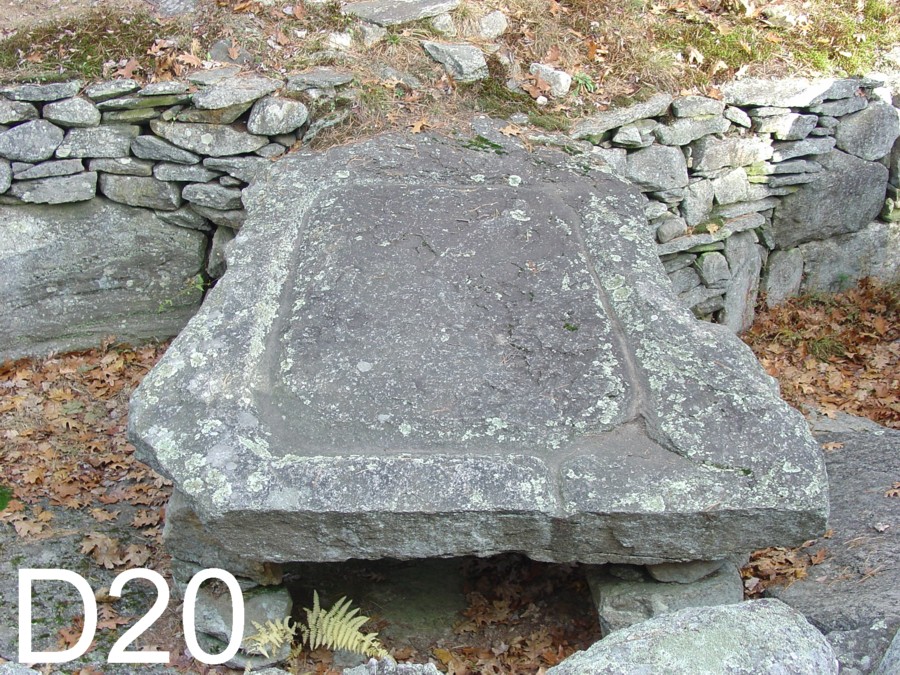
Large Grooved Stone (D20) at America’s Stonehenge.
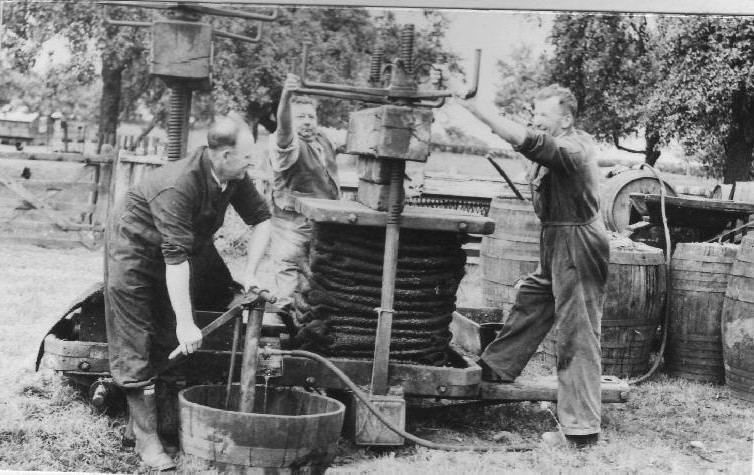
Figure 1 – Early 20th century cider press operation in the UK. (Courtesy of commanet.org online archives).
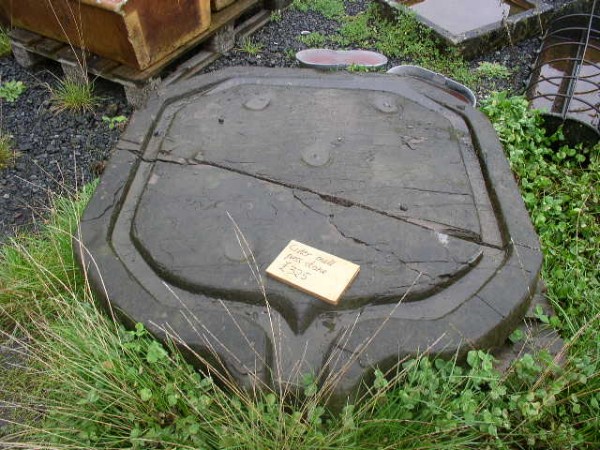
Figure 2 – Square cider press stone base with protruding spout from the UK.
(Courtesy of Leominster Reclamation & Architectural Salvage Company)

Figure 3 – Square cider press stone base with protruding spout from the UK.
(Courtesy of Leominster Reclamation & Architectural Salvage Company)
![Pinford Farm [UK] cider press Pinford Farm [UK] cider press](../assets/images/Cider-Press-Figure-4.jpg)
Figure 4 – Pinford Farm [UK] cider press. (Courtesy of commanet.org online archives)
![Lyne Down Farm [UK] cider press Lyne Down Farm [UK] cider press](../assets/images/Cider-Press-Figure-5.jpg)
Figure 5 – Lyne Down Farm [UK] cider press. (Courtesy of commanet.org online archives)
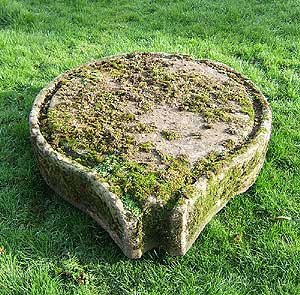
Figure 6 – Teardrop shaped cider press stone base from the UK (Courtesy of agos.co.uk website)

Figure 7 – Square shaped cider press stone base. (Old Sturbridge Village Collection)
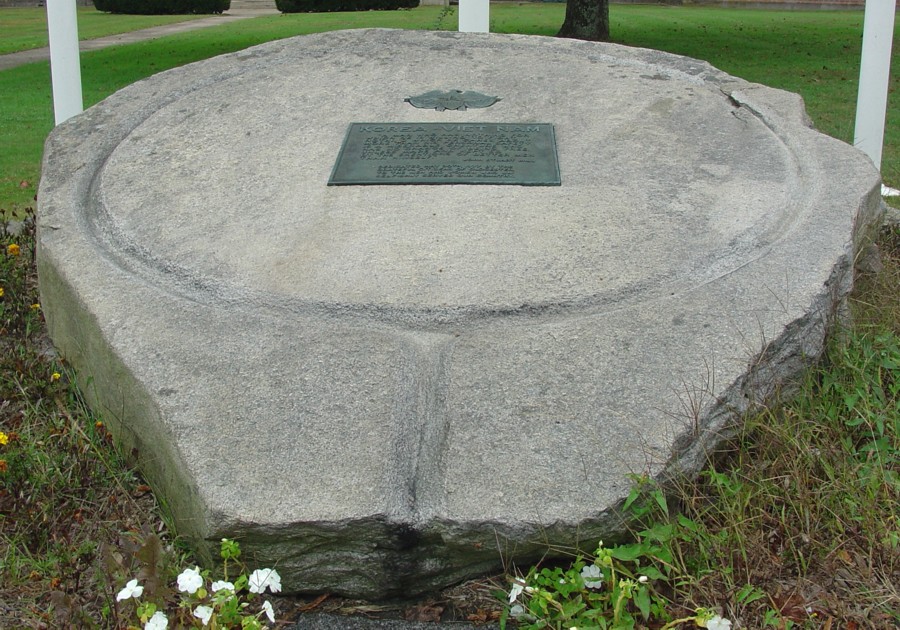
Figure 8 – Teardrop shaped cider press stone base Glocester, RI.
The references for all the articles on this website are consolidated on the Bibliography page.


